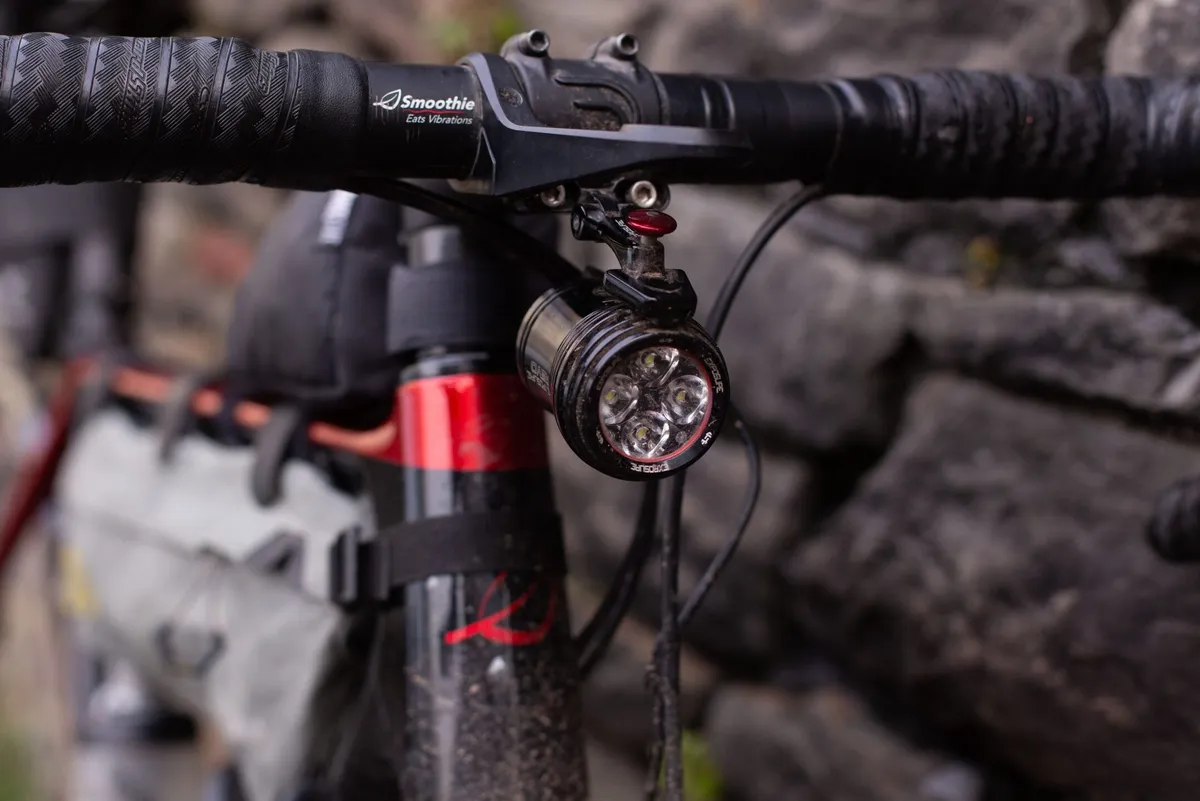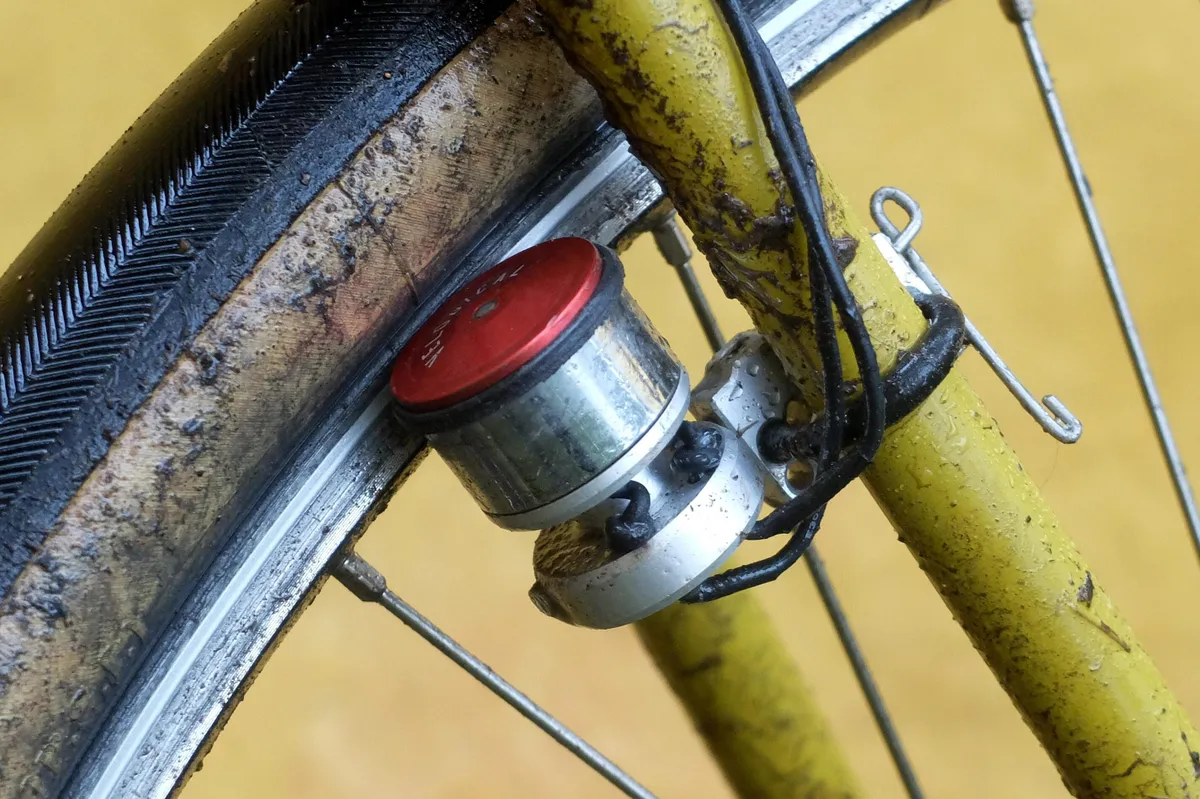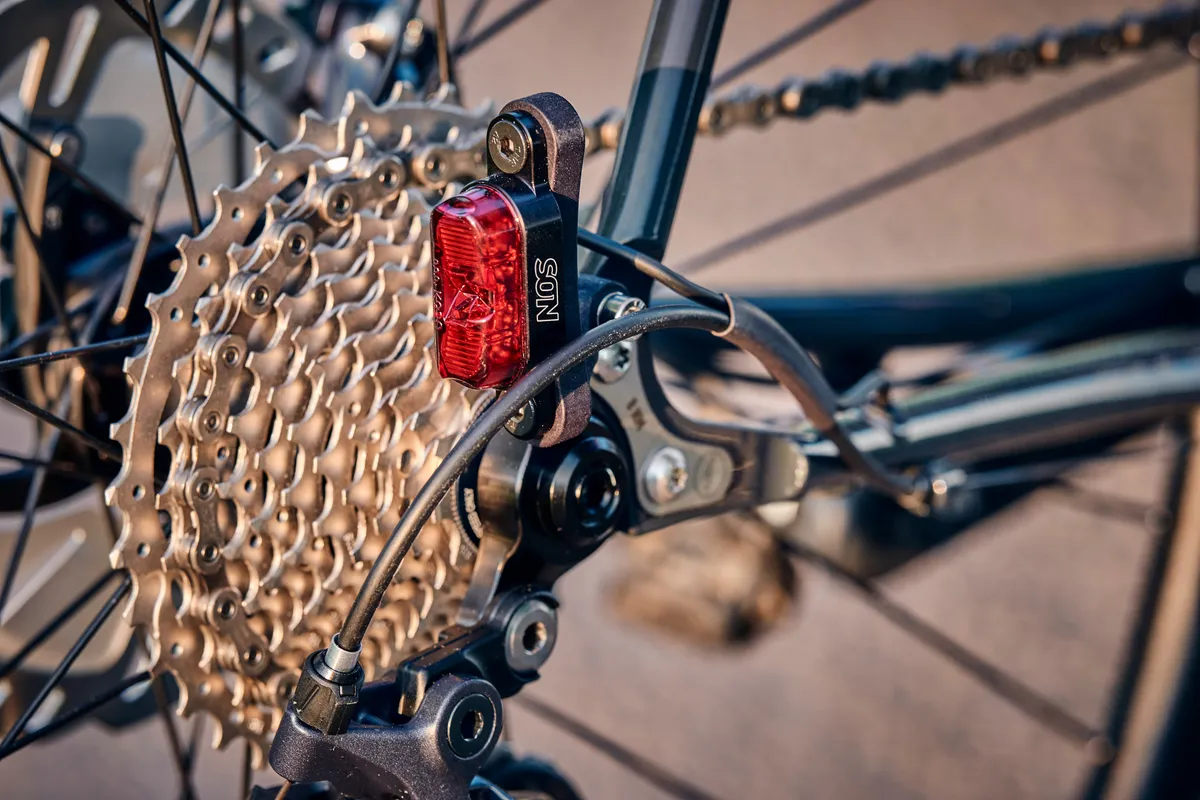After a period of relative stagnation, dynamo bike lights are making a comeback, with cool new tech and mainstream brands making noise about what was, for a very long time, a niche part of the enthusiast market.
From sleek new hubs such as the SON 29S, to Van Rysel offering limited-edition endurance road bikes with fully integrated dynamo lighting, and Canyon’s smart ECLIPS system powering adventure rigs, dynamo lighting is going mainstream.
Dynamo lights are becoming a genuine selling point for modern bikes – and I’m totally here for it.
I’ve been a dynamo botherer for a long time. The promise of absolute self-sufficiency and the opportunity to fuss with simple DIY electronics tickles my brain like licking a 9V battery.
I’m also chronically forgetful – where I once regularly stressed about remembering to charge bike lights, since I became a dynamo darling, far fewer winter rides, where lights are a must, have been abandoned.

I’m not alone: Fairlight’s co-founder and self-confessed dynamo light enthusiast, Dom Thomas, thinks there’s something more fundamental about the appeal of dynamos than cool tech alone: “On some level, I think every cyclist has a desire for self-sufficiency and escape. Moving through the city or countryside under your own steam.
“A dynamo has always been a symbol of that freedom and practicality. The idea that you could just ride off into the sunset, heading for the horizon, powered only by your legs and a little bit of clever tech.”
While we dynamo dorks have long espoused the benefits of a battery-free life, what’s behind the recent growth of interest in dynamo hubs, and where are they going next – and how did we even get here?
What even is a dynamo light?
A dynamo is a type of alternator that converts your forward motion on a bike into electrical power. Either built into a hub or a separate component that’s bolted onto your bike, dynamos are typically used to power lights or charge devices.
How did we get here?

For the very longest time, electric bike lighting systems – battery- or dynamo-powered – were pretty terrible.
People got by with those boxy Ever Ready lamps (why are their casings always the colour of tobacco-stained teeth?). However, their output was meagre and their weight immense compared to modern lights.
Dynamo lights weren’t much better – while systems from the likes of Soubitez and Union were high-quality, their power was nothing to write home about.
The advent of halogen lights pushed things a little further, but the rise of LED bulbs and affordable, powerful rechargeable batteries in the early 2000s revolutionised bike lighting.
This modern crop of lights also pushed dynamo tech well and truly into the fringes of the enthusiast market. They’ve certainly never disappeared on utility or commuting bikes, but for many years, they were rarely seen outside of audax and touring bikes.
Despite this, smaller brands quietly pushed dynamo tech forward.

SON has long been the leader in this area. Owner Wilfried Schmidt began developing his hubs in the 80s, bringing the Schmidt Original Nabendynamo to market in 1995. This was a revolutionary product, weighing about half as much and offering twice the power of leading hubs at the time.
Speaking to Bikepacking in 2022, SON said it was hard to convince riders to part with their affordable bottle dynamos, but the brand’s commitment to quality has earned it a cult following.
The SON-E6 halogen light, followed by the LED SON Edelux, pushed dynamo lighting tech forward in leaps and bounds. The latter is considered by many – myself included – to be the best light for road riding on the market.
Fellow German brand, Busch and Müller, has also been very influential in the development of dynamo light tech. The original IQ Fly was one of the first LED dynamo lights worth talking about, and it continues to produce a wide range of lamps for commuters and enthusiasts.

Supernova, Exposure, Sinewave and kLite have led the way with high-end lights for off-road riding, with novel features and handsome CNC-machined housings.
Shimano brought its first dynamo hub to market in the 2000s. As expected of Shimano, these are high-quality. And, as a result of the brand’s massive scale, they’ve long been touted as a great affordable option.
SP is the other key player in the dynamo hub market. Its first product hit the market in 2009, but it was 2012’s PL-8 that put the brand on the map. Powerful and impressively light at 400g, the PL-8 was also one of the first hubs available with a disc-brake mount.
Brands and consumers finally see the light

While they're impressive products, much of this development took place outside the mainstream view. Dynamo tech has always had a dedicated niche audience, but unless you exclusively wore Merino wool and liked bivvying in caves, they weren’t exactly part of regular conversation.
Increasing interest in long-distance, mixed-surface riding has pushed them into the spotlight – and encouraged manufacturers big and small to adopt dynamo tech.
Canyon’s general manager for road bikes, Sebastian Jadczak explains: “The rise in dynamos has been driven largely by consumer demand, especially in bikepacking and ultra-distance riding where riders need to charge multiple devices.
“It's not fun sitting around a plug socket in a cafe with a bunch of cables when you'd rather be out riding.”

On BikeRadar, despite protestations, early shoots of interest could be seen in 2018.
I now gleefully recall gently bickering with then US editor, Ben Delaney, about my Velogical bottle dynamo first look dominating the homepage. This, Ben argued, was too niche to take top spot. Then and now, I only had the highest respect for Ben, but you can only imagine my smug (if surprised) delight when it was one of the top stories for the week.
In more recent history, the news earlier this year that DT Swiss would enter the dynamo market was a remarkable – and frankly unexpected – hit on the site.
Speaking at the time, DT Swiss road marketing manager Ralf Eggert said the brand developed the wheels in response to the “increasing demand for bikepacking and commuting [products]”.
DT Swiss collaborated with SP to develop the 350 SP PL-7 at the heart of its new wheels.

SP’s vice president, Vic Chen, agrees with Eggert’s assessment: “Bikepacking is becoming increasingly popular, with more and more people enjoying travel by bike.”
He adds that: “Gravel bikes are also selling well in today’s market, which is helping drive the growing demand for dynamo hubs.”
Today’s gravel bikes are often built with long-range self-sufficiency in mind, and brands are finally designing frames with tidy dynamo cable routing and mounting points for lights.

While I think there’s something quite fetching about a classic barbershop pole-style wrap of coaxial cable around a fork leg, there’s no denying that tidily routed cables are appealing.
Fairlight’s approach to dynamo lighting integration is among the best on the market, with clear supporting documents and a huge variety of cable guides making installation neat, attractive and easy.
Thomas explains that Fairlight’s commitment to dynamos aligns closely with the brand’s values: “From day one, we’ve offered dynamo lighting solutions. Our bikes are tools – we design bikes for experiences, not trophies to sit in the corner of a room.
“The beauty of a bike lies in where it takes you, not just physically, but mentally as well – a dynamo dramatically expands the boundaries of what a bike can do.”

He adds that dynamo lights appeal to those fed up with purely performance-led bike development: “A utilitarian bike setup is also a bit of a reaction to peak aero or peak weight-weenie. It flips the script and puts the function of the bike right at the top of the list.”
Whatever their motivation, Fairlight regularly builds complete bikes for customers with a full complement of dynamo lights. This was once a rarity, but mainstream brands are now paying attention.
Gravel bikes such as the Ridley Grifn, Focus Atlas and BMC URS feature builds with dynamo lights or, at least, internal routing for dynamo cables. This would have been unthinkable a few years ago.

The recently released Van Rysel EDR CF Ultra endurance bike is another significant win for dynamo dorks. It’s one of the few bikes with a full lighting setup on a road bike out of the box, and from about as mainstream a manufacturer as they come.
Sold through Decathlon stores worldwide, this bike uses DT Swiss’ new hubs laced to Swiss Swide hubs.
There’s still room to innovate

Buoyed by this increasing demand, loads of interesting new dynamo products have entered the market – including some unexpected moves from huge brands.
Canyon’s ECLIPS system acts as a central brain for the new Grizl’s dynamo system, blending a SON 29 S hub’s dynamo power with a 3,500mAh battery. This enables lighting even at walking speeds – a key problem with most dynamo light systems – and adds a USB-C charging port for off-grid device powering.
Canyon’s Jadczak frames ECLIPS as part of broader changes in cycling tech: “This is part of an ongoing trend of digitisation of bikes, integrating tech where it adds a real user benefit.
“We expect to see options to power more accessories and devices on the bike in future – you can also imagine powering more accessories and devices on the bike in future, including electronic shifting, power meters and range extenders.”
“We’ll also see more dynamo hubs on bikes from Canyon soon,” he added.
ECLIPS is only available on premium Grizl models – there’s no word on aftermarket availability as yet. Regardless, it’s a tantalising glimpse into the future of dynamo lighting.

Revealed at Eurobike 2024, the SON 29 S is the brand’s most compact and elegant dynamo hub yet. Designed around straight-pull flanges, it’s a better visual fit for today’s gravel and adventure bikes, while delivering the same power performance as the revered SON 28.
At only 410g and priced around €549, it’s a suitably premium and handsome product that won’t look out of place on modern bikes.
Intriguing products are also entering the market from cottage manufacturers – designed and manufactured in France, the Llum dynamo light is a fully repairable, 750-lumen unit with integrated side lights, USB charging and multiple outputs for modern bikepacking setups.
It activates at only 4 km/h and includes an internal battery and capacitor for steady lighting and charging – even at low speeds or while stationary. At €349 and 180g, it’s competitively priced and very light.
Shimano’s utterly fascinating Q’Auto hub shows dynamo tech has use outside of lighting and charging.
Launched alongside the new XTR groupset, Q’auto is a self-powered automatic-shifting system powered by a dynamo-equipped rear hub. 6,500 pre-set algorithms deliver personalised gear changes based on rider input. Crucially, it also does away with a Di2 battery, potentially offering the same off-grid self-sufficiency as a dynamo lighting system with the benefits of an electronic drivetrain.
'Make it as simple and seamless as plugging in your iPhone'

All of these developments point to a – if you’ll forgive me – bright future for dynamo tech.
Thomas agrees, and thinks there’s space for bigger brands to make a mark: “SON more or less has the premium hub market to itself right now, so maybe we’ll see the big brands start to explore hub technology as well.” He adds that: “More choice and competition can only be a good thing.”
While brands such as Fairlight are happy to do the heavy lifting for customers, there’s no denying dynamo sets are still fairly DIY. No other job on your bike requires a soldering iron.
With this in mind, Thomas feels there’s room for improvement: “We're going to see a race toward minimalism and integration of lighting and charging… they'll be focused on making it as simple and seamless as plugging in your iPhone.”
Whatever the future direction of dynamo tech, I’m glad the industry and buying public have joined the SPD-sandal toting audax crowd and seen the light. And like a night-time road illuminated by my gently whirring SON 28, I look forward to seeing what’s ahead.



